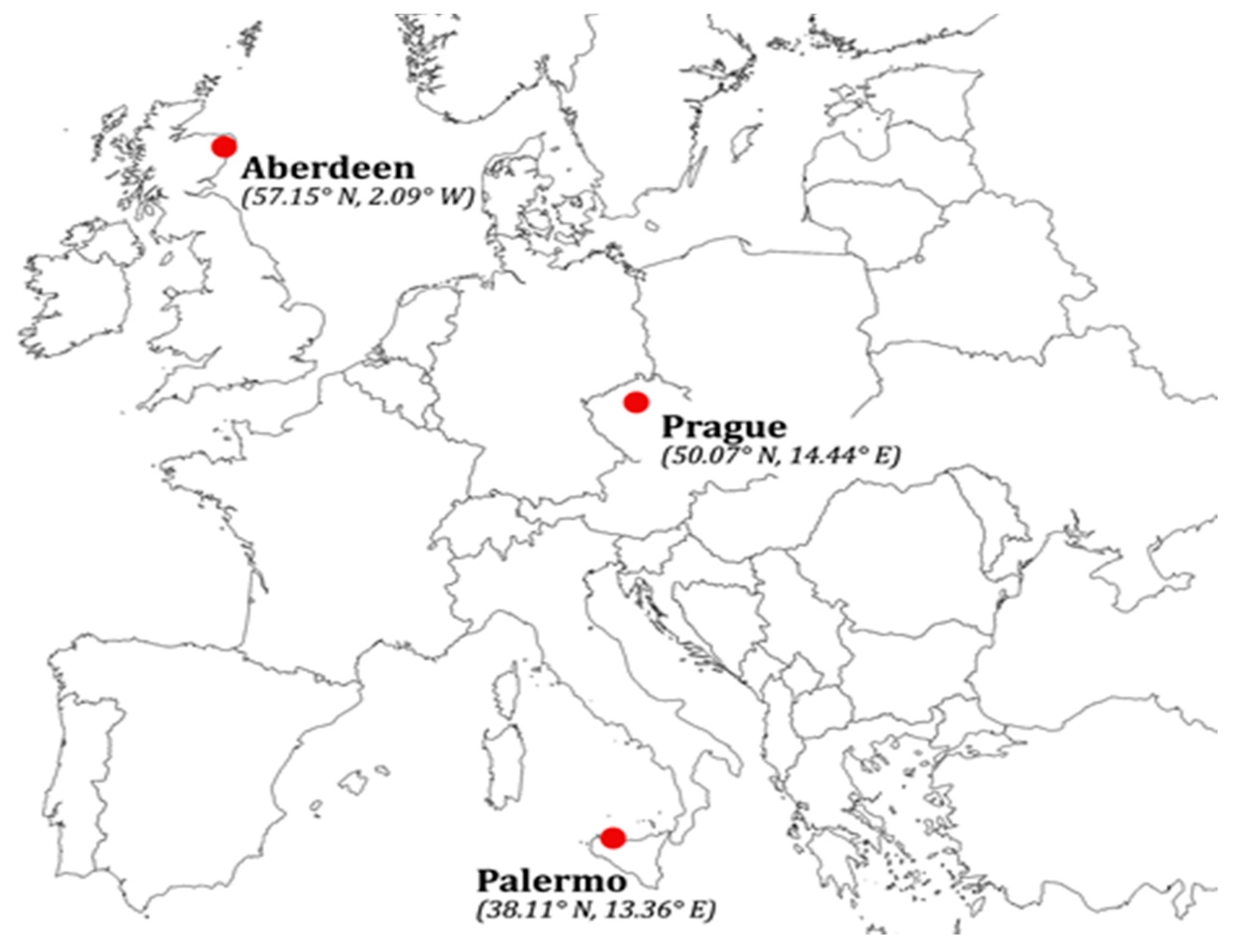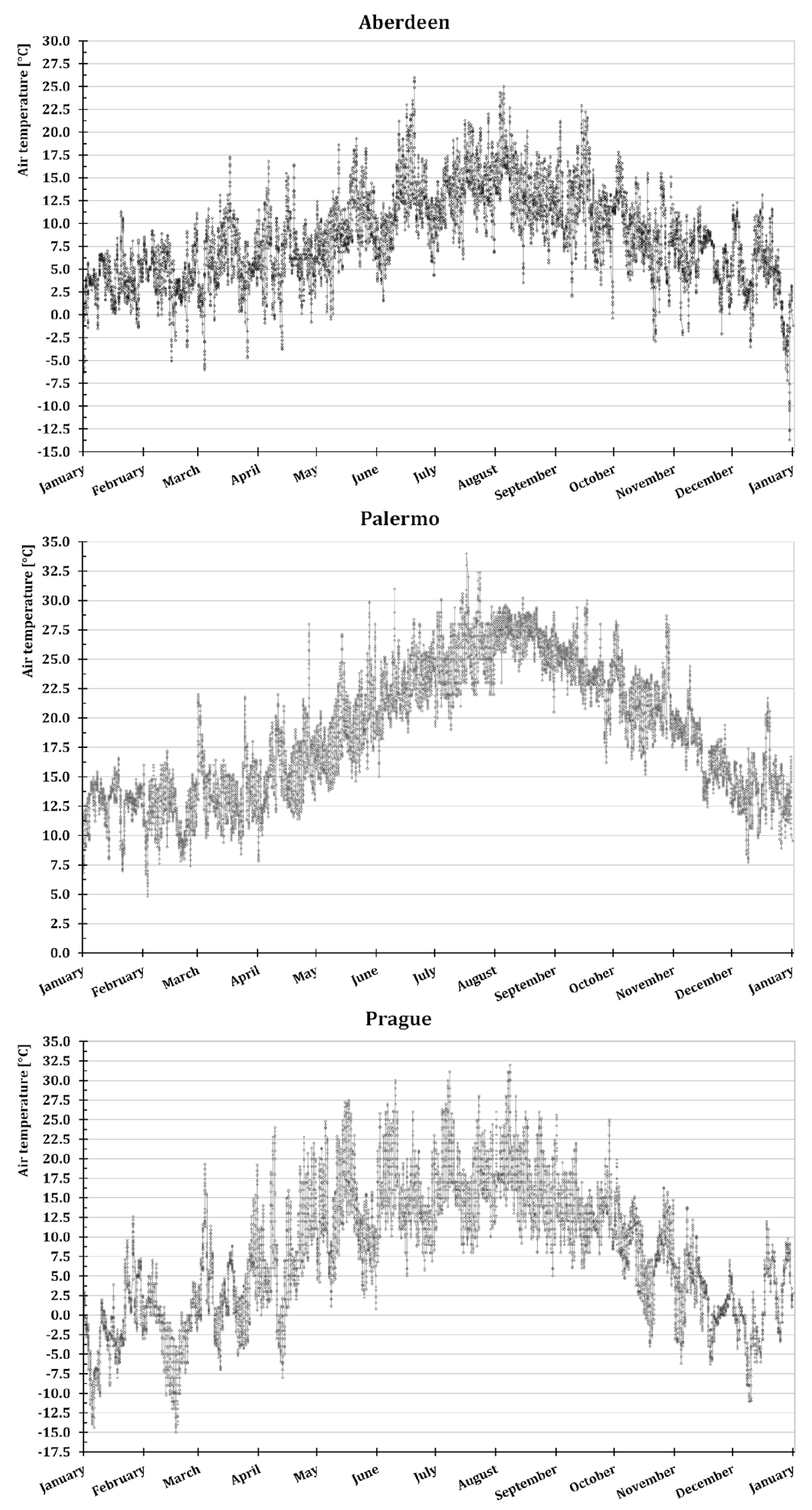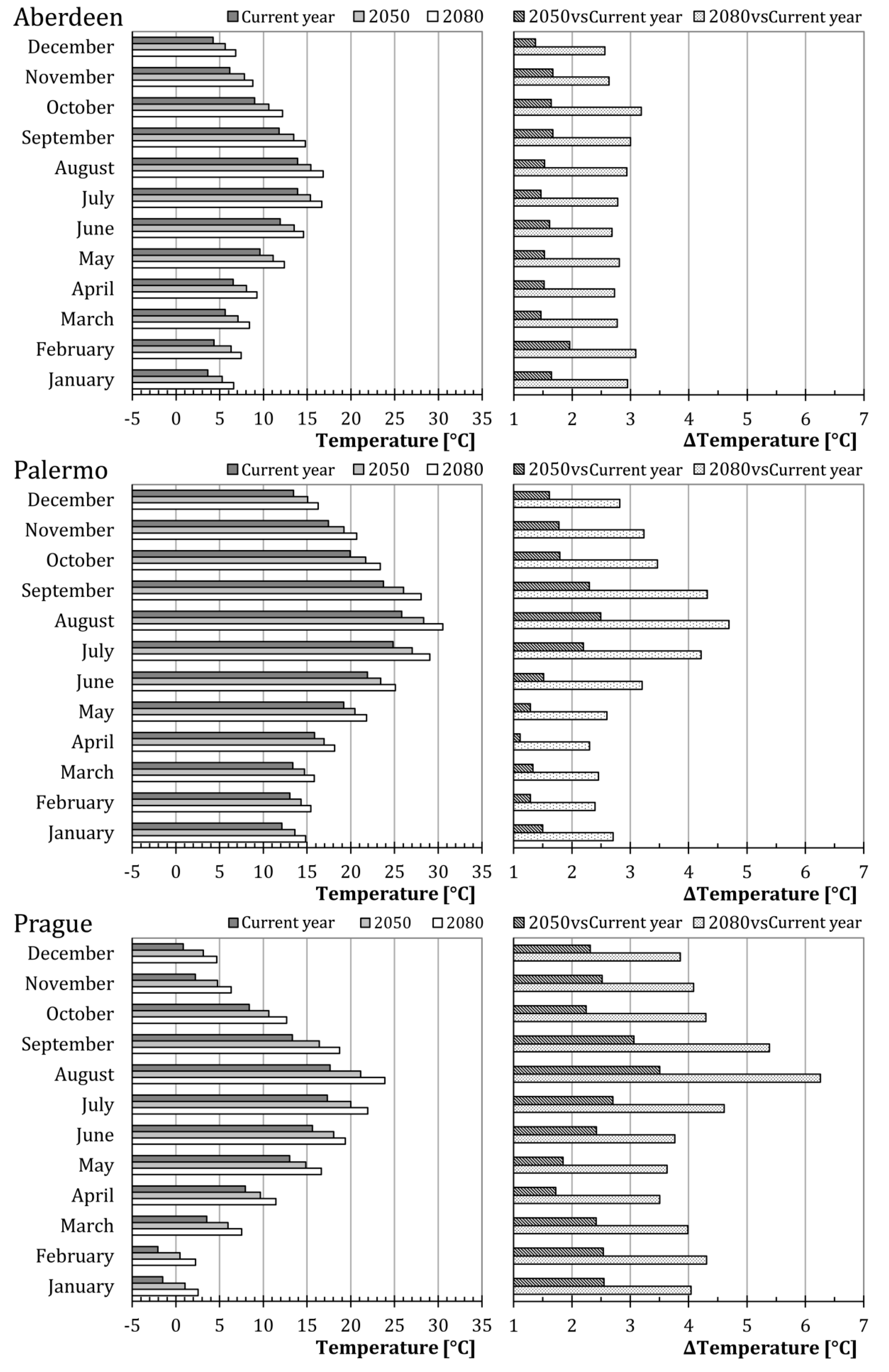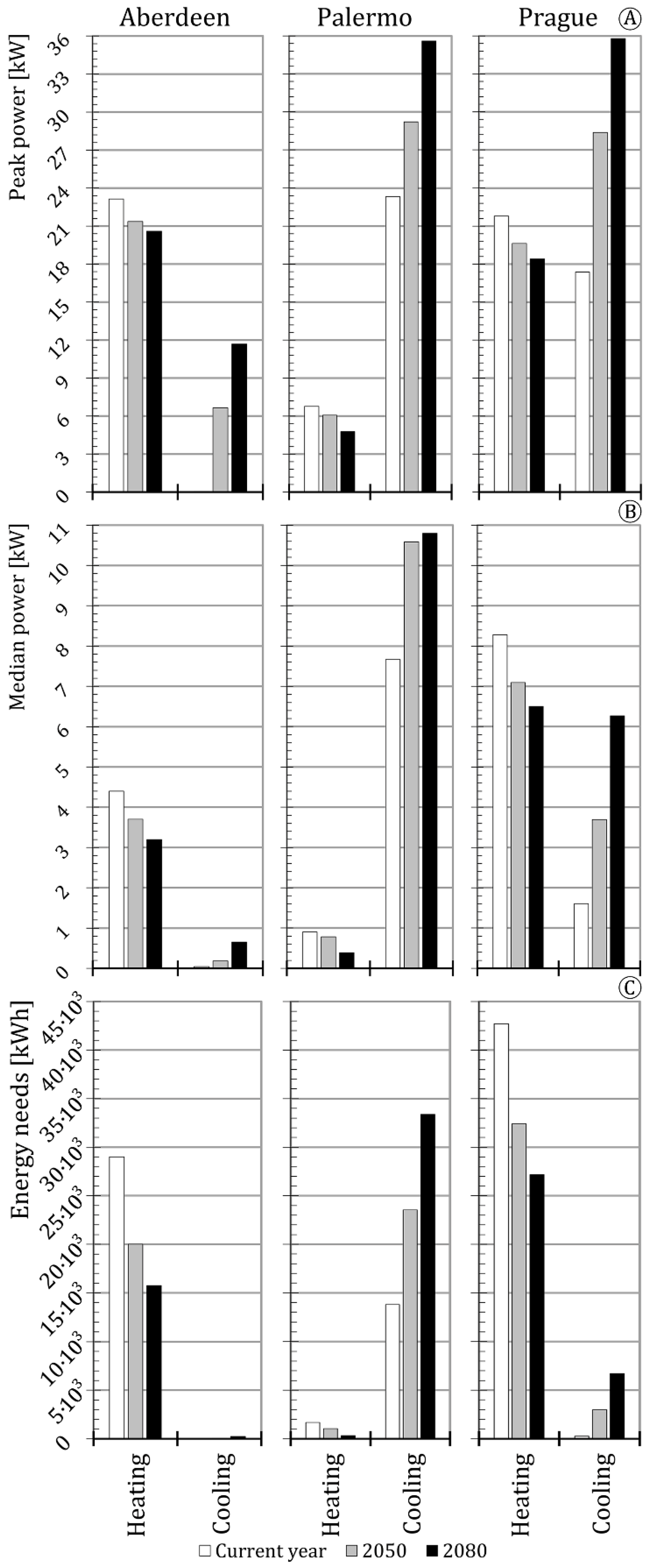Resilience of a Building to Future Climate Conditions in Three European Cities
Abstract
1. Introduction
2. Materials and Methods
2.1. Study Cities
2.2. Weather Data for the EnergyPlus Simulations
2.3. Building Properties
3. Results and Discussion
4. Conclusions
Author Contributions
Funding
Acknowledgments
Conflicts of Interest
References
- Ürge-Vorsatz, D.; Eyre, N.; Graham, P.; Harvey, D.; Hertwich, E.; Jiang, Y.; Kornevall, C.; Majumdar, M.; McMahon, J.E.; Mirasgedis, S.; et al. Energy End-Use: Buildings. In Global Energy Assessment—Toward a Sustainable Future; Cambridge University Press: Cambridge, UK, 2012; pp. 649–760. [Google Scholar]
- Cao, X.; Dai, X.; Liu, J. Building energy-consumption status worldwide and the state-of-the-art technologies for zero-energy buildings during the past decade. Energy Build. 2016, 128, 198–213. [Google Scholar] [CrossRef]
- McKinsey Global Institute. Global Energy Perspective 2019: Reference Case; McKinsey Global Institute: Washington, DC, USA, 2019. [Google Scholar]
- Salata, F.; Golasi, I.; Domestico, U.; Banditelli, M.; Lo Basso, G.; Nastasi, B.; de Lieto Vollaro, A. Heading towards the nZEB through CHP + HP systems. A comparison between retrofit solutions able to increase the energy performance for the heating and domestic hot water production in residential buildings. Energy Convers. Manag. 2017, 138, 61–76. [Google Scholar] [CrossRef]
- Ciancio, V.; Salata, F.; Falasca, S.; Curci, G.; Golasi, I.; de Wilde, P. Future energy demands of European buildings in the framework of climate change: A scoping study. In CEUR Workshop Proceedings; Geyer, P., De Troyer, F., Allacker, K., Schevenels, M.P.P., Eds.; CEUR-WS: Leuven, Belgium, 2019; p. 2394. [Google Scholar]
- Dudley, B. BP Energy Outlook 2019 Edition; BP p.l.c.: London, UK, 2019; p. 73. [Google Scholar]
- Zhao, X.; Zuo, J.; Wu, G.; Huang, C. A bibliometric review of green building research 2000–2016. Archit. Sci. Rev. 2019, 62, 74–88. [Google Scholar] [CrossRef]
- Burattini, C.; Nardecchia, F.; Bisegna, F.; Cellucci, L.; Gugliermetti, F.; Vollaro, A.; Salata, F.; Golasi, I. Methodological Approach to the Energy Analysis of Unconstrained Historical Buildings. Sustainability 2015, 7, 10428–10444. [Google Scholar] [CrossRef]
- Sadineni, S.B.; Madala, S.; Boehm, R.F. Passive building energy savings: A review of building envelope components. Renew. Sustain. Energy Rev. 2011, 15, 3617–3631. [Google Scholar] [CrossRef]
- Falasca, S.; Ciancio, V.; Salata, F.; Golasi, I.; Rosso, F.; Curci, G. High albedo materials to counteract heat waves in cities: An assessment of meteorology, buildings energy needs and pedestrian thermal comfort. Build. Environ. 2019, 163, 106242. [Google Scholar] [CrossRef]
- Lo Basso, G.; Nastasi, B.; Salata, F.; Golasi, I. Energy retrofitting of residential buildings—How to couple Combined Heat and Power (CHP) and Heat Pump (HP) for thermal management and off-design operation. Energy Build. 2017, 151, 293–305. [Google Scholar] [CrossRef]
- Chua, K.J.; Chou, S.K.; Yang, W.M.; Yan, J. Achieving better energy-efficient air conditioning – A review of technologies and strategies. Appl. Energy 2013, 104, 87–104. [Google Scholar] [CrossRef]
- Allouhi, A.; El Fouih, Y.; Kousksou, T.; Jamil, A.; Zeraouli, Y.; Mourad, Y. Energy consumption and efficiency in buildings: Current status and future trends. J. Clean. Prod. 2015, 109, 118–130. [Google Scholar] [CrossRef]
- Andrić, I.; Pina, A.; Ferrão, P.; Fournier, J.; Lacarrière, B.; Le Corre, O. The impact of climate change on building heat demand in different climate types. Energy Build. 2017, 149, 225–234. [Google Scholar] [CrossRef]
- AR5 Climate Change 2014: Impacts, Adaptation, and Vulnerability—IPCC. Available online: https://www.ipcc.ch/report/ar5/wg2/ (accessed on 8 February 2019).
- Coakley, J.A.; Hansen, J.E.; Hofmann, D.J. Anthropogenic Perturbation of Tropospheric. Science 1992, 255, 423–430. [Google Scholar]
- Kershaw, T.; Eames, M.; Coley, D. Assessing the risk of climate change for buildings: A comparison between multi-year and probabilistic reference year simulations. Build. Environ. 2011, 46, 1303–1308. [Google Scholar] [CrossRef]
- Moazami, A.; Nik, V.M.; Carlucci, S.; Geving, S. Impacts of future weather data typology on building energy performance—Investigating long-term patterns of climate change and extreme weather conditions. Appl. Energy 2019, 238, 696–720. [Google Scholar] [CrossRef]
- Guan, L. Preparation of future weather data to study the impact of climate change on buildings. Build. Environ. 2009, 44, 793–800. [Google Scholar] [CrossRef]
- Ciancio, V.; Falasca, S.; Golasi, I.; Curci, G.; Coppi, M.; Salata, F. Influence of input climatic data on simulations of annual energy needs of a building: EnergyPlus and WRF modeling for a case study in Rome (Italy). Energies 2018, 11, 2835. [Google Scholar] [CrossRef]
- Shen, P. Impacts of climate change on US building energy use by using downscaled hourly future weather data. Energy Build. 2017, 134, 61–70. [Google Scholar] [CrossRef]
- Sanders, C.H.; Phillipson, M.C. UK adaptation strategy and technical measures: The impacts of climate change on buildings. Build. Res. Inf. 2003, 31, 210–221. [Google Scholar] [CrossRef]
- Camilleri, M.; Jaques, R.; Isaacs, N. Impacts of climate change on building performance in New Zealand. Build. Res. Inf. 2001, 29, 440–450. [Google Scholar] [CrossRef]
- Li, M.; Guo, J.; Tian, Z.; Shi, J.; Xiong, M.; Xiang, C. Future climate change and building energy demand in Tianjin, China. Build. Serv. Eng. Res. Technol. 2014, 35, 362–375. [Google Scholar] [CrossRef]
- Dirks, J.A.; Gorrissen, W.J.; Hathaway, J.H.; Skorski, D.C.; Scott, M.J.; Pulsipher, T.C.; Huang, M.; Liu, Y.; Rice, J.S. Impacts of climate change on energy consumption and peak demand in buildings: A detailed regional approach. Energy 2015, 79, 20–32. [Google Scholar] [CrossRef]
- Invidiata, A.; Ghisi, E. Impact of climate change on heating and cooling energy demand in houses in Brazil. Energy Build. 2016, 130, 20–32. [Google Scholar] [CrossRef]
- Chan, A.L.S. Developing future hourly weather files for studying the impact of climate change on building energy performance in Hong Kong. Energy Build. 2011, 43, 2860–2868. [Google Scholar] [CrossRef]
- Kalvelage, K.; Passe, U.; Rabideau, S.; Takle, E.S. Changing climate: The effects on energy demand and human comfort. Energy Build. 2014, 76, 373–380. [Google Scholar] [CrossRef]
- Jylhä, K.; Jokisalo, J.; Ruosteenoja, K.; Pilli-sihvola, K.; Kalamees, T.; Seitola, T.; Mäkelä, H.M.; Hyvönen, R.; Laapas, M. Energy demand for the heating and cooling of residential houses in Finland in a changing climate. Energy Build. 2015, 99, 104–116. [Google Scholar] [CrossRef]
- Barbosa, R.; Vicente, R.; Santos, R. Climate change and thermal comfort in Southern Europe housing: A case study from Lisbon. Build. Environ. 2015, 92, 440–451. [Google Scholar] [CrossRef]
- Nik, V.M.; Sasic Kalagasidis, A. Impact study of the climate change on the energy performance of the building stock in Stockholm considering four climate uncertainties. Build. Environ. 2013, 60, 291–304. [Google Scholar] [CrossRef]
- Wan KK, W.; Li DH, W.; Pan, W.; Lam, J.C. Impact of climate change on building energy use in different climate zones and mitigation and adaptation implications. Appl. Energy 2012, 97, 274–282. [Google Scholar] [CrossRef]
- Wang, X.; Chen, D.; Ren, Z. Assessment of climate change impact on residential building heating and cooling energy requirement in Australia. Build. Environ. 2010, 45, 1663–1682. [Google Scholar] [CrossRef]
- Ouedraogo, B.I.; Levermore, G.J.; Parkinson, J.B. Future energy demand for public buildings in the context of climate change for Burkina Faso. Build. Environ. 2012, 49, 270–282. [Google Scholar] [CrossRef]
- Peel, M.C.; Finlayson, B.L.; Mcmahon, T.A. Updated world map of the Koppen-Geiger climate classification. Hydrol. Earth Syst. Sci. Discuss. 2007, 4, 439–473. [Google Scholar] [CrossRef]
- Kottek, M.; Grieser, J.; Beck, C.; Rudolf, B.; Rubel, F. World map of the Köppen-Geiger climate classification updated. Meteorol. Z. 2006, 15, 259–263. [Google Scholar] [CrossRef]
- Jentsch, M.F.; Bahaj, A.S.; James, P.A. Climate change future proofing of buildings—Generation and assessment of building simulation weather files. Energy Build. 2008, 40, 2148–2168. [Google Scholar] [CrossRef]
- Mavrogianni, A.; Davies, M.; Batty, M.; Belcher, S.E.; Bohnenstengel, S.I.; Carruthers, D.; Chalabi, Z.; Croxford, B.; Demanuele, C.; Evans, S.; et al. The comfort, energy and health implications of London’s urban heat island. Build. Serv. Eng. Res. Technol. 2011, 32, 35–52. [Google Scholar] [CrossRef]
- Trimble Inc. SketchUp. Available online: https://www.sketchup.com/it (accessed on 4 August 2019).
- National Renewable Energy Laboratory. OpenStudio. Available online: https://www.openstudio.net/ (accessed on 4 August 2019).
- Crawley, D.B.; Hand, J.W.; Kummert, M.; Griffith, B.T. Contrasting the capabilities of building energy performance simulation programs. Build. Environ. 2008, 43, 661–673. [Google Scholar] [CrossRef]
- Deru, M.; Field, K.; Studer, D.; Benne, K.; Griffith, B.; Torcellini, P.; Liu, B.; Halverson, M.; Winiarski, D.; Rosenberg, M.; et al. US Department of Energy Commercial Reference Building Models of the National Building Stock; National Renewable Energy Laboratory: Golden, CO, USA, 2011. [Google Scholar]
- Jentsch, M.F.; Chang, C.K.; James, P.A.; Bahaj, A.S.; Yau, Y.H. Development of climate change adapted weather files for building performance simulation. In Proceedings of the 3rd International Conference on Sustainable Energy and Environment (SSE 2009), Bangkok, Thailand, 18–23 May 2009; pp. 1–6. [Google Scholar]







| Type | Orientation | Surface [m2] |
|---|---|---|
| Opaque | North | 258.6 |
| East | 111.6 | |
| South | 184.5 | |
| West | 81 | |
| Roof | 181.5 | |
| Floor | 181.5 | |
| Glass | North | 59.7 |
| East | 7.6 | |
| South | 112.3 | |
| West | 6.4 |
| Heating Season | Num Hours [-] | Tmean1 [°C] | Stand Dev1 [°C] | Tmin1 [°C] | Tmedian1 [°C] | |
|---|---|---|---|---|---|---|
| Aberdeen | Now | 5427 | 5.67 | 3.55 | −13.24 | 5.62 |
| 2050 | 4233 | 6.42 | 3.20 | −11.14 | 6.41 | |
| 2080 | 3646 | 7.27 | 3.14 | −10.24 | 7.29 | |
| Palermo | Now | 1037 | 11.71 | 2.35 | 5.94 | 11.63 |
| 2050 | 664 | 12.85 | 2.22 | 7.64 | 12.77 | |
| 2080 | 292 | 13.38 | 1.93 | 8.74 | 13.29 | |
| Prague | Now | 4810 | 2.12 | 5.58 | −14.71 | 1.83 |
| 2050 | 4172 | 3.46 | 4.89 | −11.51 | 3.23 | |
| 2080 | 3719 | 4.43 | 4.61 | −9.61 | 4.23 | |
| Cooling Season | Num Hours [-] | Tmean1 [°C] | Stand Dev1 [°C] | Tmax1 [°C] | Tmedian1 [°C] | |
|---|---|---|---|---|---|---|
| Aberdeen | Now | 2 | 24.45 | 0.3 | 24.67 | 24.45 |
| 2050 | 40 | 21.34 | 2.13 | 25.97 | 21.12 | |
| 2080 | 109 | 21.14 | 2.37 | 27.31 | 20.88 | |
| Palermo | Now | 1289 | 24.03 | 2.97 | 34.27 | 23.99 |
| 2050 | 1978 | 26.42 | 3.18 | 36.77 | 26.77 | |
| 2080 | 2668 | 27.96 | 3.4 | 38.87 | 28.46 | |
| Prague | Now | 117 | 23.92 | 3 | 30.83 | 23.58 |
| 2050 | 552 | 23.37 | 4.42 | 36.88 | 22.71 | |
| 2080 | 859 | 24.92 | 5.13 | 41.04 | 24.38 | |
| City | Year | Heating | Cooling |
|---|---|---|---|
| Aberdeen | 2050 | –31% | 55,014% |
| 2080 | –46% | 259,129% | |
| Palermo | 2050 | –37% | 71% |
| 2080 | –80% | 142% | |
| Prague | 2050 | –24% | 973% |
| 2080 | –36% | 2316% |
© 2019 by the authors. Licensee MDPI, Basel, Switzerland. This article is an open access article distributed under the terms and conditions of the Creative Commons Attribution (CC BY) license (http://creativecommons.org/licenses/by/4.0/).
Share and Cite
Ciancio, V.; Falasca, S.; Golasi, I.; de Wilde, P.; Coppi, M.; de Santoli, L.; Salata, F. Resilience of a Building to Future Climate Conditions in Three European Cities. Energies 2019, 12, 4506. https://doi.org/10.3390/en12234506
Ciancio V, Falasca S, Golasi I, de Wilde P, Coppi M, de Santoli L, Salata F. Resilience of a Building to Future Climate Conditions in Three European Cities. Energies. 2019; 12(23):4506. https://doi.org/10.3390/en12234506
Chicago/Turabian StyleCiancio, Virgilio, Serena Falasca, Iacopo Golasi, Pieter de Wilde, Massimo Coppi, Livio de Santoli, and Ferdinando Salata. 2019. "Resilience of a Building to Future Climate Conditions in Three European Cities" Energies 12, no. 23: 4506. https://doi.org/10.3390/en12234506
APA StyleCiancio, V., Falasca, S., Golasi, I., de Wilde, P., Coppi, M., de Santoli, L., & Salata, F. (2019). Resilience of a Building to Future Climate Conditions in Three European Cities. Energies, 12(23), 4506. https://doi.org/10.3390/en12234506








